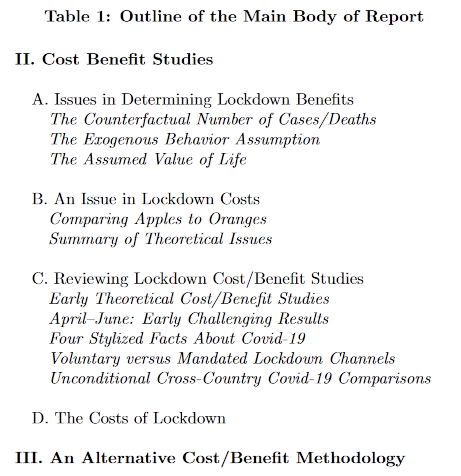Economist Douglas W. Allen of Simon Fraser University recently published his Covid Lockdown Cost/Benefits:A Critical Assessment of the Literature where he concludes that “it is possible that lockdown will go down as one of the greatest peacetime policy failures in Canada’s history”:
In my forty years as an academic, I’ve never seen anything like the response and reaction to Covid-19. The research response has been immense, with estimates of over 40,000 papers related to the topic produced in one year. This research covers every imaginable aspect of Covid-19, and over the course of the past year knowledge about the virus, the human reactions to it, and the consequences of these reactions has exploded. In one word, the Covid-19 information cascade has been “overwhelming.”
In contrast, the ubiquitous media, public health, and political response to the pandemic has been one-sided, incomplete, and almost unchanging over the past year. With respect to lockdown policies, many political jurisdictions have repeated the same spring 2020 programs in 2021, ignoring what has been learned in the meantime. Often public announcements were made that were inconsistent with basic Covid-19 facts that were easy to look up if you know where to look. Furthermore, when research results contrary to the official government response were shared on social media, they were often pulled from social media platforms. As a result, for average Canadians the public media and official public health news conferences have been the only source of Covid-19 information.
This review of a small segment of the literature is intended to give some guidance for those who would otherwise not have access to academic research. The focus is to only critically assess the cost/benefit studies that have been written over the past year on lockdown policies related to the Covid-19 pandemic.
The report covers over 80 different academic studies and related Covid-19 datasites. I have sought out studies that i) dealt with matters of “lockdown” either directly or indirectly, and ii) were related directly or indirectly to issues relevant to the costs or benefits of lockdown.
The term “lockdown” is used to generically refer to state actions that imposed various forms of non-pharmaceutical interventions. That is, the term will be used to include mandatory state-enforced closing of non-essential business, education, recreation, and spiritual facilities; mask and social distancing orders; stay-in-place orders; and restrictions on private social gatherings.
“Lockdown” does not refer to cases of “isolation,” where a country was able to engage in an early and sufficient border closure that prevented trans-border transmission, followed by a mandated lockdown that eliminated the virus in the domestic population, which was then followed by perpetual isolation until the population is fully vaccinated. This strategy was adopted by a number of island countries like New Zealand. Here I will only consider lockdown as it took place in Canada and most of the world; that is, within a country where the virus became established.
This is a complicated report because it covers a wide range of studies, and deals with a wide range of issues. Table 1 outlines the substance of the report. Sections II: A and B, discuss four critical assumptions often made within the context of estimating benefits and costs. Understanding these assumptions explains why early studies claimed that the benefits of lockdown were so high, and also explains why the predictions of those models turned out to be false.
Section II: C, examines major cost/benefit studies completed over the first six months of the pandemic, and then focuses on what I believe to be the critical factor: distinguishing between mandated and voluntary changes in behavior. This section concludes with an interpretation of some unconditional death comparisons across countries that are typically reported in the media. Section II: D surveys the research done on the costs of lockdown. Finally, Section III. presents a simple alternative cost/benefit methodology to generate two cost/benefit ratios of lockdown.
H/T to Stephen Green for the link.




